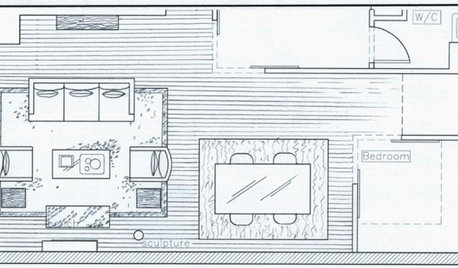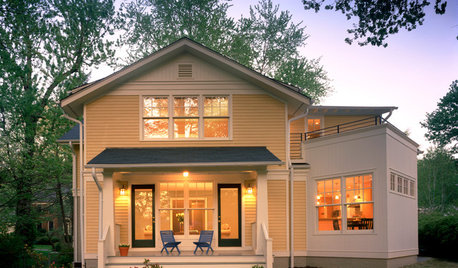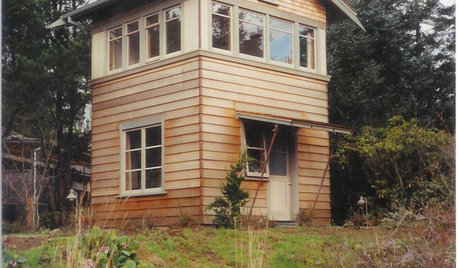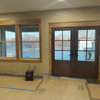Architect said buying online plans useless..need to be redrawn??
Hi all,
I haven't been here in awhile. We ended up finding a different lot do to issues with the other. We are now back to trying to do house design.
We found a couple of nice plans online that would need some minor modifications...some exterior changes and a few rooms that need to be shuffled. Nothing major. Our builder suggested we talk to his local architect about modifications. The local guy wants 7-8k to do the modifications because he says the online plans need to be redrawn. In addition, he said the websites cannot provide archtectually sealed and signed docs to submit for permit...so it's basically a waste of money.
We are in Bucks Co. PA...not sure if that makes a difference. We have a builder we are asking questions but he is very lax in getting back...nor have we definitely hired him..so hard to get precise answers. Insight please.
Comments (36)
renovator8
11 years agolast modified: 9 years agoIt is extremely rare for a state or city to require a professional designer (architect or engineer) to design a single family house. Only the stamp of an engineer would be required for structural elements that are not prescribed in the 1&2 family dwelling code. You need to find out what the requirement is for your location.
Online plans are sometimes complete but usually not since they have no idea where the house will be built. To be able to revise the drawings without redrawing them it would be necessary to get the digital (CAD) version from the website. That is sometimes not possible and when it is it can be expensive since selling the digital file would allow someone to use and/or sell the drawings over and over.
To get a builder interested it often helps to have a set of drawings. Then the builder knows you are serious and knows what you want.
The reason the architect wants more than a modification fee is because he knows that once he starts modifying the design the original design will get forgotten and he could spend as much time modifying the design as he would if he had started from scratch. An architect isn't going to draw a house and not suggest better ways to accommodate your needs, taste and the site conditions.
virgilcarter
11 years agolast modified: 9 years agoAs has been said before about similar situations, it's better to pay several thousand dollars up front, than to pay tens of thousands of dollars later when surprises and necessary changes arise from unforseen situations.
You want a house that will fit your site conditions, functional needs and wants, plus your budget right? And one that is handsome and pleasing to the eye? How to you expect to get that from a magazine, with a few erasures and a new line or two, added here or there?
Good luck!
Related Professionals
Clive Architects & Building Designers · Palmer Architects & Building Designers · West Palm Beach Architects & Building Designers · Ronkonkoma Architects & Building Designers · Oak Hills Design-Build Firms · Lake Station Home Builders · South Sioux City Home Builders · Stanford Home Builders · De Pere General Contractors · Ewing General Contractors · Mankato General Contractors · Northfield General Contractors · Riverdale General Contractors · Union Hill-Novelty Hill General Contractors · Winfield General Contractorsfarmhousegirl
Original Author11 years agolast modified: 9 years agoRenovator, Thanks. Who would I ask to find out what the requirement is? Our builder said this is correct due to copyright you can't modify. Seems like a lot of people on here are finding stock plans..yet our builder and architect say it's useless.
renovator8
11 years agolast modified: 9 years agoJust ask the local building inspector if an architect is required to stamp the drawings for a single family house in order to get a permit to build it (not counting the structural part that an engineer is required to stamp).
Your builder and architect seem to be making exaggerated characterizations about the drawings for sale on the internet but perhaps you misunderstood what they said.
The copyright on the design drawings is intended to prevent people from using the design without paying for it. If you purchase the design drawings you have the right to use them to build one house and the only problem with modifying the drawings is that they are usually on plain bond paper.
Many plan services will sell you "reproducible" prints that can be erased and drawn over for an additional charge. Others will sell you the digital CAD files that you can change all you want. But these formats are more expensive.
Some documents bought on the internet are not professionally prepared and all of them must be modified for local conditions. Many services will modify the documents for an additional fee but don't expect the person making the changes to be professionally trained.
Anyone who offers their time and expertise for a fee is not going to advise you to use a service that does it on the cheap so don't expect the architect and builder to welcome your approach. If they didn't think they could do a better job they should be in another business.
John Tee is an Atlanta architect who offers pre-designed house drawings as follows:
Example - The Livingston:
CAD file $2,500
Reproducible mylar $1,725
8 set construction package $1,250
Pricing Set $990
Planning Set $260What Plans Include:
Our plan packages offer a complete conceptual design of our homes. However, our working drawings are not fully engineered construction documents for a specific building site.
CAD File
- Copies: 1
- Building License : Yes
- Copyright Release: Yes
For use by design professionals to incorporate your changes to the house plans. Includes these documents:
- Floor plans
- Foundation or basement plan
- Exterior Elevations
- Roof plan
- Building sections
- Typical wall sections
- Electrical Plans
- Interior Elevations, notes and details
The included license is for building one house only. CAD File sets are not available with all house plans. Changes to plans should only be made by qualified professionals, please contact us for an estimate.Reproducible Package
- Copies: 1
- Building License: Yes
- Copyright Release: Yes
For making minor changes to your house plans. Delivered on mylar. Includes these documents:
- Floor plans
- Foundation or basement plan
- Exterior Elevations
- Roof plan
- Building sections
- Typical wall sections
- Electrical Plans
- Interior Elevations, notes and details
The included license is for building one house only. Changes to plans should only be made by qualified professionals, please contact us for an estimate.Construction Set
- Copies: 1
- Building License: Yes
- Copyright Release: No
The basic package of drawings that you need to build your home as designed. Includes these documents:
- Floor plans
- Foundation or basement plan
- Exterior Elevations
- Roof plan
- Building sections
- Typical wall sections
- Electrical Plans
- Interior Elevations, notes and details
The included license is for building one house only.Planning Set
- Copies: 2
- Building License: No
- Copyright Release: No
For planning purposes only and Stamped "Not for Construction." A contractor cannot legally build from plans marked this way. Includes these documents:
- Floor plans
- Exterior ElevationsWhat’s Included
Foundation and floor-framing plans. This shows the foundation layout, including drawings for a basement, slab, or crawlspace. Only one type is included with each plan. Support walls and all necessary dimensions are part of this sheet. Please note that there is no beam layout included with foundation plans. Foundation plans must be engineered locally.
Dimensioned floor plans. Each floor of the house is shown in detail. The position and dimensions of walls, doors, windows, staircases, and columns are clearly indicated. Door and window sizes are also included.
Suggested Electrical plans. Included are suggestions for the placement of switches, outlets, and fixtures. Local code and your builder will dictate exact placement.
Building sections. These cross sections shows building construction. Also a typical wall from footings to roofline.
Exterior elevations. These pages provide drawings of the front, rear, left, and right sides of the house. They also suggest the appropriate materials for the structure and detail work.
Interior elevations. These include detailed drawings of cabinets, fireplaces, columns, other built-in units, or suggested trim profiles. Each plan has various degrees of detail.What’s Not Included
Heating and plumbing plans. Due to regional variations in climate and building codes, heating and plumbing plans should be supplied by local contractors.
Material quantity lists. Once your personal selections are made (types of windows, doors, etc.), this list should be obtained from the contractor you choose or from a local building materials supplier.Architectural and engineering seals. Some cities and states require a licensed architect or engineer to review and seal a blueprint, or officially approve it, prior to construction due to concerns over energy costs, safety, and other factors. If you require a seal, please contact us for availability.
renovator8
11 years agolast modified: 9 years agoHere is John Tee's website in case you like traditional architecture.
Here is a link that might be useful: John Tee Architect
virgilcarter
11 years agolast modified: 9 years agoWonderful suggestions. Let's go to Walmart or Home Depot for our house plans and not worry about anything.
And for our medical, dental and optical care, education, legal situations, religion, investment, retirement, care of our pets, children's after school activities and other possibily important needs, just use Google. There's someone everywhere who will do it for less. Like Ebay, but hurry, bid time is running out.
What could possibly go wrong?
Life is good. Carry on!
mydreamhome
11 years agolast modified: 9 years agoBuy a CAD file of the plan with copyright release if at all possible and take it to either an architect or a designer locally who can visit your site and incorporate your changes accordingly. That is the easiest(and often least expensive) way to do it. If you're dealing with a house plan mill, see if you can find out who the original architect was, then either visit their site to see if a CAD w/ copyright release is avail or pick up the phone and give them a call. Like Renovator8, I'm partial to John Tee's plans too.
Hope this helps!
robin0919
11 years agolast modified: 9 years agoIt sounds like the GC and architect are just trying to make extra money. My understanding with 'reproducible' plans, you can make modifications and build as many houses with that plan as you want. This is exactly what Frank Betz does with their houses. They are based in Atlanta.
gaonmymind
11 years agolast modified: 9 years agoA ton of good architects sell their home plan in Atlanta and modify all the time. Spitzmiller and Norris, Historical Concepts, Stephen Fuller, Lew Oliver, Mitch Ginn...the list could go on. Walmart? I think not...lol. I do think you should use the original architect to modify however. A site plan is usually what is needed to get things going
renovator8
11 years agolast modified: 9 years agoThe copyright on the design drawings remains intact when you buy a house plan; you just get a license to use it for one house and one house only whether you buy it in the CAD, reproducible, or print format. All the plan services make that quite clear.
There is no reason the designer would or could object if you modified the drawings after buying them. That designer can't tell you what you can build. It would be very difficult if not impossible to build a house exactly as it was offered for sale on the internet.
The question was not whether or not to use a plan service instead of an architect, it is how to use an architect and a plan service. Most would steal the design and ask the architect to use it as the basis for their work. The OP is trying to buy the design and have an architect modify it.
In my experience, whichever way it is done, the original design is in the trash can by the end of the first design meeting with the architect so I doubt it makes sense to buy the CAD file.
The better way to do this is to collect photos from the real world, magazines, the internet and the Garden Web and show them to your architect and let him/her design a house for you. Your architect has an insurmountable advantage over the internet designer so use it.
renovator8
11 years agolast modified: 9 years agoMost, if not all, plan services offer a multi-use license for a much higher price but Betz forces a homeowner to pay that price for their CAD or mylar drawings when the homeowner doesn't need a multi-use license.
Betz seems to focus their business on builders and developers rather than individual homeowners. The architect run sites usually offer much better services, designs and documents for a small additional fee.
renovator8
11 years agolast modified: 9 years agoI suspected that Frank Betz had started as a supplier of plans to developers and builders. Of course, he's retired from the business now.
"In the beginning Frank Betz Associates, Inc., concentrated on developing custom plans for the speculative builder. Over the years, Frank Betz Associates, Inc., has grown to be one of the nation's leading home plan designers, providing plans and products to builders and consumers alike."
I would expect these plans to need a lot of attention before being used to build.
cleanfreak0419
11 years agolast modified: 9 years agoThere is some truths in the OP's question/concerns. I have built 2 houses and now I am on my 3rd. Two were Frank Betz plans and this one is a Stephen Fuller plan. All three had to be redone to some degree because the codes have changed and they do not update their plans to accommodate the changes. The worst is the stair tread code. It used to be 9", but in 2009 it changed to 10". This requires another foot or more of landing area which is already tight in most of these plans. The plans also state to check with your local building dept to be sure of the new codes in affect. If you don't, you will have a nightmare trying to figure it out during the build.
renovator8
11 years agolast modified: 9 years agoThe 7 3/4" riser and 10" tread requirement was first introduced 17 years ago in the 1995 CABO code (predecessor of the IRC) and the IRC had it in the first edition in 2000 and in 2003 and in 2006 as well as 2009.
Some states have amendments that allow the old dimensions and energy code upgrades city by city so it is impossible for the plan mills to design well for all locations. They should make the changes for you for free or offer CAD files at the same price as prints so the plans can be easily corrected. But they apparently don't trust us to not resell the design files; I wonder why.
virgilcarter
11 years agolast modified: 9 years agoSo here we are: on the one hand we have a cheap house plan factory whose plans don't meet code, don't take into consideration local site and climate conditions (views, grade, access, winter/summer conditions, etc.) and may/may not meet all of an owner's needs and wants.
On the other hand, we have local architects, design-build firms and others who know local codes, local conditions, including the construction market, who want reasonable compensation for their time, effort and expertise.
What's a person to do? It's a good thing we have this forum to exchange information, don't you think?
auroraborelis
11 years agolast modified: 9 years agomydreamhome - wow! $1/sq ft, in our area we got a great deal on ours, at $4.24/sq ft! And that is a designer, lot a licensed architect so we had to pay an extra $1/sq ft for structural engineering.
To the OP, I am in the final stages of planning our home, so I am by no means an expert, but here is my suggestion. Call the company whose plan you it is you want to modify and get some information about what it would cost to modify, and what building code is used in the plan. If you can outline exactly what changes you want they can likely give you a fairly good idea of the costs. Then find out what is needed in your local area, most likely you will still need it stamped by a structural engineer in your state. Also, many of the plans are drawn to a national standard, so you can ask your local building department how that relates to your local requirements. You may be surprised, that with the required changed the cost may be similar to getting something entirely custom. Also, if the plan is on one of the generic websites see if you can figure out who the actual designer is (Frank Betz, Mascord etc) and deal directly with that individual instead of the larger site. Perhaps you want to post your plan here as well for help on that one!
Compare that to the cost of the getting the plan done by a local architect or designer + engineer. In the end the cost may be similar, and you will be better off with the local architect/designer as they will be more familiar with the local process. My local designer is submitting the plans for us, and dealing directly with the county on all questions/comments that arise as part of his fee so that really saves us a lot of time, and headaches. That is the kind of support you wouldn�t get when you purchase most plans, however not all districts are tough to deal with, I�ve learned on here that some basically approve plans without much review so it will vary in how important that support is.
We started out wanting to buy a plan online and have it modified, and we were really close to doing that with a plan from Mascord, however in the end we wanted someone we could deal with face to face, and who would help use deal with our county�s building department. It is great that we did, because in the end our plan is nothing like the plan we started with for inspiration, and the designer has been a wealth of information on referrals and on helping us ensure we have everything in order. There was civil engineering (topographic map, site plan and drainage plan), Geotechnical (soil) Engineering and hoops to jump through with the local utility company, all of which we would not have been aware of if we had not been working with someone local.
renovator8
11 years agolast modified: 9 years agoThere is another thing you should consider if you want an architect to modify an internet design. An architect is held to higher standard of liability because he/she is licensed by the state and is therefore understandably reluctant to take responsibility for the work of others.
Since stamping work not done by them or under their direct supervision is prohibited by law, doing so is usually not covered by their insurance. An architect can be sued along with everyone else even if the damages had nothing to do with his/her services. So, you should not be surprised if an architect is reluctant to modify a set of contract documents for a small fee.
As for the $1.00/s.f fee, that's about what I charged for full architectural design services for a house in Hollis, NH in 1973. That year a new Audi 100LS was $5,400 and gas was 36 cents a gallon. At that fee rate today, I would be looking for a cardboard box to sleep in tonight.
My guess is that for that fee rate you would be getting an apprentice who knows less about the design of a house than the draftsman who drew up the internet house plans.
Check out the modification horror stores on the Garden Web. Plan services don't have a room full of architects modifying their drawings; these people are independent contractors who work at home and when something goes wrong the plan provider claims they are not responsible for the work.
You may save a few thousand dollars by hiring a "designer" or by modifying a pre-designed plan but that doesn't solve the problem already described: all the competitive bids coming in too high. And hiring a design-build contractor can provide little price, design or quality control. We see evidence of this every day on the forum. There are no simple solutions to this dilemma but one does exist.
I believe the best solution is to hire an architect and then interview contractors until you and your architect agree on a good one. Then the 3 of you would work together to produce a design that meets your needs, the building code and the budget keeping a detailed cost estimate as you go. You would then negotiate a Cost of the Work with a Fixed Fee contract with a Guaranteed Maximum Price. Although there is a price guarantee, the sub contracts would be bid competitively and the GMP would be raised if the Owner wanted to use a sub other than the low bidder.
To motivate the Contractor to hold costs below the GMP there can be a Shared Savings; in other words if the Cost of the Work is lower than the GMP, the Owner splits that amount with the Contractor (usually 60% for the Owner and 40% for the Contractor). This approach is very effective in controlling costs.
I have built a lot of buildings with this project delivery method for college dormitories, high tech offices, and hotels because the owners believed it was the fastest and most cost effective method. I have also used it for single-family houses and additions. It avoids the pitfalls we read about on this forum on a daily basis. It does require some project management skill on the part of the Contractor and an Owner would need an architect to oversee their end of the deal.
arch123
11 years agolast modified: 9 years agoI think it would always be a better idea to go to the original designer/arch on changes to a house plan. The changes would be more consistent with the original house plan. That was our experience when we built a house. The designer had a much better vision for our house and the changes we wanted and we were delighted with the results.
stinkytiger
11 years agolast modified: 9 years agoHi,
I think the key point is one of what will get past your local town building inspector.
Typically he / she will want a plan with a sign off / stamp from a State Licensed Engineer or Architect. I.E. if your house falls down, he will simply point the finger at the engineer / architect. Hence legally and liability wise he / she is covered.
All engineers and or architects when they sign off on something need to know if the design is sound. If they designed it themselves or were involved in the process the will know and be comfortable. If you get a plan from somewhere, they will have to analyze the building from top to bottom, and may not be comfortable on the sign off in any case because they do not know the assumptions built into the "unknown" plan. Some engineers / architects will do this, but it is not that cheap. Remember it is his career on the line here.
The other important thing is your land. If your land is flat and is easy to build, no surprises, then a off the shelf plan will work better. If your land is slopey, has alot of potential issues, EPA, water, river, septic, rocks etc, then a off the shelf plan would probablly need so much work that you might as well start from scratch.
If you like plans from the internet, I would work backwards. Find someone who will sign off on the plan and present it to the local town inspector. If you can do that then you are golden. Note getting that sign off however may not be as easy as you think.
Best, Mike.
Kelly
11 years agolast modified: 9 years agoPerhaps it depends on how much tweaking it needs. I just had the first mtg with our architect. I showed him a stock plan I like and we talked about changes needed. He will be drawing a plan from scratch and gave me a small discount since the stock plan gives him a better idea of what I want and will save him time. I thought this approach was fair.
brickeyee
11 years agolast modified: 9 years ago"Hence legally and liability wise he / she is covered."
The AHJ has no liability for anything unless you can show outright criminal fraud (like payments to pass inspections).
The do not need any protection, and in man paces if everything you do is in accordance with the building code in affect there is no reason for a whole lot of engineering (or architectural design).
It is structural items NOT covered in the code that require stamping off, and it is easy to run into them.
Basement I-beams (the one running down the middle of the basement) are a common item not covered by the building code.
A basement support wall is far easier, but now you do not have an open large basement.
virgilcarter
11 years agolast modified: 9 years agoLet's set the record straight here, because brickeyee is sorely mistaken.
The Architectural and Engineering regulations of virtually every state that have such regulations mandate that it is illegal for an architect or an engineer to stamp and certify any documents that they did not personally prepare and that were not prepared under their direct supervision. Period.
The reason for this should be self obvious. It is why architects and engineers do not simply receive drawings from a house plan factory, stamp them and go out to lunch.
Come on folks. If you want serious professional experience and advice, then seek it. If you want to do it yourself (and your jurisdiction allows you to do so), then proceed full speed ahead and accept responsibiliy for what may/may not ensue.
Do we select our school teachers, pastors, physicians, dentists, yada yada the way we approach building a house? Come on...
sweet.reverie
11 years agolast modified: 9 years agoWell because we have a very small budget... we worked with a designer. I drew a plan and sent that with a bunch of Houzz ideabooks and we came back with a plan- he was $1.00 square foot. I posted it here because there were parts I did not like and the designer could not really fix because that is not really what he did. SO a nice poster here redid my plan perfectly and I sent that to the designer and we are now building that house... LOL. So you could go that route :)
renovator8
11 years agolast modified: 9 years agoVirgil Carter is correct about architect and engineer professional practice rules but Brickeyee was correctly pointing out that only structural elements of a house that are NOT specifically prescribed in the applicable building code would need to be stamped by an engineer and I will add that a stamp for "engineered lumber" beams can be easily gotten from the manufacturer through the local supplier and that the requirement for an architect's stamp for the rest of the work is extremely rare and in many areas no stamp of any kind is required.
So, the first step in the design process is to discover what your building official requires in order to grant you a building permit and a certificate of occupancy. Buy the applicable building and zoning codes (or find them online) and check with the plans examiner at the local fire service, Historic Commission and Conservation Commission (wetlands) if they exist. Get a survey before it snows.
You are the one responsible to the state and local regulatory agencies so trust no one to get this stuff right.
brickeyee
11 years agolast modified: 9 years ago" "engineered lumber" beams can be easily gotten from the manufacturer through the local supplier"
And roof trusses if you use them, and any number of structural components.
I have a local steel yard that will even stamp off for simple work.
Why should I sped money (and extend MY liability) on something included in the cost of the material?
renovator8
11 years agolast modified: 9 years agoYour liability is unlikely to change in any case because you are a design professional.
We may have lost the thread here.
virgilcarter
11 years agolast modified: 9 years agoYes, now I see the point about "engineered" materials, and I agree that such materials are really not the focus of this thread, if I understand it correctly.
The point has been made that it's essential to check with one's local jurisdiction to see what is required. That's the beginning point for everyone everywhere.
An important note about the building code: the building code identifies the required MINIMUM standards for various sub-assemblies. It in no way attempts to be the overall specific engineering or architectural design for any structure. The requirements from the building code, in fact, are only for various critical sub-parts and individual elements of a structure, under the conditions specified in the code. In no way does the building code consider the specific and overall design criteria or standards for an entire structure, as far as I know. And if the local conditions differ or are exceeded from that assumed by the building code, the code provisions are inapplicable.
I wonder what the court decision would be if there was a catastrophic failure in a building and the defendant's case was "I just followed the building code requirements"?
All of this is just another way of saying that there is no shortcut for the knowledge and experience of a licensed building professional when it comes to the design, construction and supervision of a building project.
Certainly, many structures are built without licensed design professionals. And certainly, many are safe. If that's what interests you, and you can legally do so, then by all means give it your best shot.
Just don't expect a licensed building professional to accept a set of drawings from a far-distant plan factory, stamp them and return them to you. If they do, they likely have broken state law, if their state has an Architect & Engineers Act, as most do.
I wonder how a cardiologist might respond to someone who walked into their office and asked for medications and medical fees based on a no-cost description about heart disease printed out from the Internet? Only a thought about a comparable situation.
renovator8
11 years agolast modified: 9 years agoOk let's talk about codes. I have found the CABO/ICC building codes to cover the critical design elements of a house very well with only a few exceptions because the minimum is often the optimum for such a lightly loaded short structure. If you designed joists using the formulas you were taught in school they would be the same as you would get using the code tables except in borderline cases the code always rounds upward and doesn't adjust for poorly graded lumber, etc.
The IRC requires LVL's and I-joists to be designed by an engineer but in Maine the state law allows a builder to do that if he/she submits the manufacturer's sizing tables and the loading conditions with the drawings for the building permit. The state law was changed to exempt a builder from the prohibition of practicing engineering for a house in 07, so you can imagine what an architect's license means in Maine. I don't think Vermont even has a residential building code yet and there are other states that are similar or where the code is adopted or not adopted by each county and enforcement is not consistent due to lack of staff.
Anyway, the biggest deficiency to the codes that I know of is the flexibility of floor joists. The deflection limit at maximum loading is intended to prevent ceiling plaster from cracking and is not very helpful. Many long span joists are legal but excessively bouncy and there are no simple rules of thumb that eliminate this problem. I tried to write one and a week later I couldn't understand it. Unfortunately bridging and blocking have been found to do little to stiffen typical joist sizes.
I also find the ICC foundation section to be inadequate but the code allows the option to use ACI318 which is an excellent standard and design guide but any code standard must be limited to a maximum amount of unbalanced fill; an engineer would be needed to design a cantilevered retaining wall.
The code deals with typical regional wind and snow loads pretty well but not high wind, drifted snow and earthquake loads. At any rate, I won't design anything without an engineer involved even if he isn't required to stamp the drawings. I like his insurance policy a lot.
I think a contractor could use the building code as a defense in court but it would be of less use for a licensed design professional.
For me the medical analogies are interesting but not realistic. It is still acceptable in certain parts of the US to build your own house without any oversight or control by anyone (except possibly the local electric coo-op) and this idea is considered a right to many. I think the practice of medicine has advanced considerably farther than the house building industry.
worthy
11 years agolast modified: 9 years agoI just had the first mtg with our architect. I showed him a stock plan I like and we talked about changes needed. He will be drawing a plan from scratch and gave me a small discount since the stock plan gives him a better idea of what I want and will save him time.
I've been building new homes since '89. At first, I used plans from design services supposedly following Code. Until one day while waiting for a drywall delivery my carpentry contractor and project manager realized that except for the perimeter, only one or two 2x4s were holding up half the second floor of a 3,800 sf home. They quickly devised and installed a system of posts at supporting points. We beat the drywall delivery! The plans had been examined by the City, the building inspected by the City and warranty programme inspectors and no one had noticed this slipup.
After that close call, I have a professional engineer review and stamp every plan I use.
***
I can't imagine any licenced architect working for a $1 a foot!!
You can get an unqualified "designer" here for that and I know small builders who do use them. It can work on a simple small house.
Here we also have licenced architectural technologists , who are well-trained and knowledgeable. Their rates average $3.25 s.f.
For a 4,600 sf+ custom home I'm now toying with, architects quoted me $40,000 to $100,000+.
Unfortunately, architecture (like writing) is one of those things that everybody thinks they can do just given enough time. It's a delusion only strengthened by the proliferation of CAD programmes.
virgilcarter
11 years agolast modified: 9 years agoThanks for these two good examples of why experienced and licensed design professionals offer value to home owners and builders. Even though residential single-family dwellings may appear simple, often they may not be.
Of course, America was founded on an individual and religious freedom basis and settled through a strong, pioneering spirit. Hopefully, these qualities are still in great supply.
Dwellings have gotten considerably more complex than a single-room, felled timber enclosure, however, so it may be prudent for one to pause and give some consideration to what may be involved (and what may subsequently happen) before one goes out and beggins cutting trees to build one's home. At the end of the day, however, it's still an individual decision (subject to pesky applicable laws and regulations) as to how it's best to proceed on an individual basis.
brickeyee
11 years agolast modified: 9 years ago"Your liability is unlikely to change in any case because you are a design professional. "
It adds another entity to the liability pool, thus changing things.
One with far deeper pockets than mine.
If there is a problem my insurance will be going after them.
It is SOP for tort attorneys to sue everyone they can think of, and then let the court sort out actual liability.
renovator8
11 years agolast modified: 9 years agoWorthy makes some very good points but he still can't spell.
dustycoyote
11 years agolast modified: 9 years agoI purchased CAD plans online. I am very happy with them and my draftsman was impressed. Try contacting a draftsman instead of an architect. Much less expensive!! Like you, I am just making minor changes. Once you purchase the plans you can legally make any changes you want. Most of the websites will state this. Feel free to email me if you have more questions. Good luck.
renovator8
11 years agolast modified: 9 years agoI can imagine that a draftsman would be impressed by a full set of construction documents but someone with more building knowledge should determine if the drawings are appropriate for your site and meet the local building code. Don't rely on the local building inspector to do that job for you. Saving now can cost you later.
jrschmidt
11 years agolast modified: 9 years agoHi Farmhousegirl,
As it turns out I am about to begin building in Bucks County (Holland) as well. I am curious as to how your build went/is going. I am currently looking for an architect and that is how I found this post.
Regards,
John



















mydreamhome